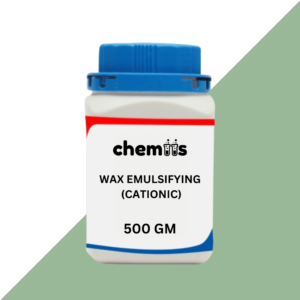Wax Emulsifying Anionic is a specialized emulsifier designed to facilitate the blending of oils, waxes, and water in various formulations. As an anionic emulsifier, it carries a negative charge and interacts effectively with positively charged substances in formulations, helping to stabilize and improve the texture of emulsions. This emulsifying agent is widely used in cosmetics, personal care products, and industrial applications where stable emulsions are required.
It is particularly effective in creating stable oil-in-water emulsions in skin creams, lotions, and various other personal care products, providing both stability and a smooth, desirable texture.
Applications of Wax Emulsifying Anionic
1. Cosmetics and Personal Care
- Creams and Lotions:
Wax Emulsifying Anionic is commonly used in the formulation of creams, lotions, and moisturizers. Its ability to stabilize oil-in-water emulsions makes it a key ingredient in formulations designed for dry or sensitive skin. - Shampoos and Conditioners:
It is used in hair care products such as shampoos and conditioners to help mix oils with water and provide a smooth, creamy consistency. Its conditioning properties also contribute to hair softness and manageability. - Facial Cleansers and Scrubs:
It is frequently found in face cleansers and exfoliating scrubs, where it helps to create a smooth texture and emulsify the active ingredients, ensuring even distribution across the skin. - Deodorants and Antiperspirants:
This emulsifier is used in deodorant formulations, helping to emulsify waxes and oils and ensuring a consistent texture. It also contributes to the smooth application of the product. - Sunscreens and After-Sun Care:
In sunscreen formulations, Wax Emulsifying Anionic helps to stabilize the emulsion of oils and water, ensuring the even distribution of UV filters. It also provides a smooth texture to the product, which is essential for easy application.
2. Industrial Applications
- Lubricants and Greases:
Wax Emulsifying Anionic is also used in industrial applications, especially in the formulation of wax-based lubricants and greases. Its ability to emulsify waxes with water and oils is critical for creating stable and high-performance lubricants. - Polishes and Coatings:
It is used in the production of furniture waxes, car polishes, and other coating products. The emulsifier helps create a smooth, consistent texture while improving the durability and shine of the final product. - Textile and Leather Treatments:
This emulsifier is sometimes used in the textile and leather industries to improve the smoothness and finish of fabrics and leathers. It helps emulsify oils and waxes, resulting in a conditioned, smooth texture. - Agricultural Products:
Wax Emulsifying Anionic can also be found in agricultural formulations, where it is used to emulsify oils, surfactants, and other additives in pesticide, herbicide, and fertilizer formulations.
3. Food Industry (Limited Use)
- Food Coatings:
In some food applications, Wax Emulsifying Anionic may be used to form stable emulsions in coatings and other specialty formulations, although its use is typically regulated and must comply with specific food safety standards.
Safety Handling of Wax Emulsifying Anionic
1. Hazards and Safety Information
- Non-Toxic:
Wax Emulsifying Anionic is generally considered non-toxic when used in appropriate quantities and as intended. However, as with all chemicals, it should be handled with care. - Skin and Eye Contact:
Direct contact with the product may cause mild irritation, especially in the eyes or on sensitive skin. Always wear protective gloves and safety glasses to avoid irritation or injury. - Inhalation:
While Wax Emulsifying Anionic is not typically a significant inhalation risk, any dust created by the powdered form should be avoided. Inhalation of dust may cause mild respiratory irritation.
2. Personal Protective Equipment (PPE)
- Gloves:
Wear appropriate gloves when handling the emulsifier, particularly in its powdered form, to avoid skin irritation and allergic reactions. - Safety Glasses or Goggles:
Wear safety goggles or glasses to protect against accidental splashes or contact with eyes. - Respiratory Protection:
If handling large quantities in powder form, use a dust mask or respiratory protection to prevent inhalation of airborne particles.
3. Handling and Storage
- Handling Instructions:
When using Wax Emulsifying Anionic, ensure that the workspace is well-ventilated. Always mix the emulsifier with appropriate ingredients according to the formulation guidelines. Avoid prolonged contact with the skin or eyes. - Storage Instructions:
Store Wax Emulsifying Anionic in a cool, dry place, away from direct sunlight or extreme temperatures. Keep the container tightly sealed to prevent contamination and preserve the product’s effectiveness. - Shelf Life:
The emulsifier has a long shelf life when stored properly in its original packaging, away from moisture and direct heat.
4. Disposal Instructions
- Waste Disposal:
Dispose of any excess or waste material according to local regulations for industrial chemicals. Wax Emulsifying Anionic should not be disposed of in drains or water systems. - Spill Cleanup:
In the event of a spill, absorb the material with an inert absorbent such as sand or vermiculite. Sweep up the material and place it in a suitable waste disposal container. Clean the area with soap and water.
5. First Aid Measures
- Skin Contact:
In case of skin contact, wash the affected area with soap and water. If irritation develops, seek medical advice. - Eye Contact:
Rinse immediately with plenty of water for at least 15 minutes, lifting the eyelids occasionally. Seek medical attention if irritation persists. - Inhalation:
If inhaled, move to an area with fresh air. If breathing difficulties persist, seek medical attention immediately.








Snehal More (verified owner) –
Satisfied with the results.
Manish Chauhan (verified owner) –
Very fast delivery.
Bhavika Shah (verified owner) –
Arrived earlier than expected.
Meenal Shah (verified owner) –
Amazing value for money.
Deeksha Iyer (verified owner) –
Secure payment options.
Tushar Kohli (verified owner) –
Repeat customer, always happy.
Akash Tripathi (verified owner) –
Better than local suppliers.
Rajeev Bhagat (verified owner) –
Delivered in good condition.
Deeksha Iyer (verified owner) –
Fast response to queries.
Aditya Rawat (verified owner) –
Reasonably priced.